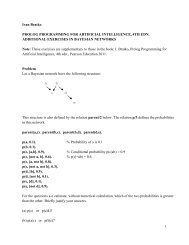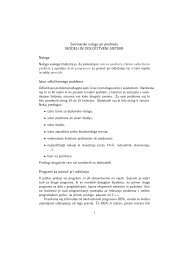Detecting Fortresses in Chess
Detecting Fortresses in Chess
Detecting Fortresses in Chess
Create successful ePaper yourself
Turn your PDF publications into a flip-book with our unique Google optimized e-Paper software.
36 GUID, BRATKO<br />
Figure 1. In the left side diagram, the white player is to move and has a w<strong>in</strong>n<strong>in</strong>g positional advantage. State-of-the-art chess<br />
programs without any exception choose the move 1.Na4xb6 (white knight takes the black queen), which leads to a big material<br />
advantage. However, after 1...c7xb6 (black pawn takes the white knight) 2.h3-h4 (otherwise Black plays 2...h5-h4 with a draw)<br />
2...g5xh4 3.Qb2-d2 h4-h3! 4.g2xh3 h5-h4 Black’s position (see the diagram on the right side) becomes an impregnable fortress<br />
and the w<strong>in</strong> is no longer possible aga<strong>in</strong>st adequate defence. Nevertheless, as GM Dvoretsky <strong>in</strong>dicates, white has a w<strong>in</strong>n<strong>in</strong>g plan<br />
at disposal: Qb2-d2! followed by, Ka2-b3, Na4-b2, Kb3-a4, Nb2-d3-c1-b3. By execut<strong>in</strong>g this plan, White can ga<strong>in</strong> the a5-pawn<br />
and w<strong>in</strong> the game.<br />
regardless of the search depth. ∗ That is, although the<br />
program’s evaluation function assesses positions <strong>in</strong> this<br />
endgame as won, it fails to dist<strong>in</strong>guish between nonequally<br />
promis<strong>in</strong>g positions for achiev<strong>in</strong>g the f<strong>in</strong>al goal:<br />
deliver<strong>in</strong>g checkmate. This results <strong>in</strong> a rather ridiculous<br />
play by the w<strong>in</strong>n<strong>in</strong>g side.<br />
In 100 simulations mate-<strong>in</strong>-16 positions where the<br />
program played aga<strong>in</strong>st the black player defend<strong>in</strong>g optimally<br />
(us<strong>in</strong>g tablebases), the program did not manage to<br />
deliver checkmate with<strong>in</strong> prescribed 50 moves <strong>in</strong> several<br />
games, even at a 12-ply search. For example, at a 10-<br />
ply search the program did not w<strong>in</strong> <strong>in</strong> 19 games, and the<br />
average length of the won games was 32 moves. Despite<br />
the fact that the program is aware of the 50-move rule † ,<br />
it does not help it to always avoid the draw, when the<br />
depth of search is limited.<br />
The same program, when us<strong>in</strong>g the shallow search<br />
of only 2 plies (i.e., when the phenomenon does not<br />
occur), checkmates the opponent <strong>in</strong> 100% of the games<br />
played from randomly chosen positions, also f<strong>in</strong>ish<strong>in</strong>g<br />
the task <strong>in</strong> considerably less moves on average. It is<br />
worth not<strong>in</strong>g that the backed-up evaluations of the 2-<br />
ply search were on average <strong>in</strong>creas<strong>in</strong>g as the simulated<br />
games were proceed<strong>in</strong>g, while at search depths where<br />
the phenomenon occurs they always stayed the same,<br />
unless the depth of search sufficed to f<strong>in</strong>d a pr<strong>in</strong>cipal<br />
∗ The program where this phenomenon occurs is “RYBKA 2.1c 32-<br />
bit”. In the year 2006, this was the highest rated chess program. The<br />
phenomenon no longer occurs <strong>in</strong> the later versions.<br />
† The basic rules of the game accord<strong>in</strong>g to FIDE say: “The game<br />
may be drawn if each player has made at least the last 50 consecutive<br />
moves without the movement of any pawn and without any capture.”<br />
variation that ended <strong>in</strong> checkmate (when the heuristic<br />
evaluation is no longer necessary).<br />
3 HOW TO DETECT FORTRESSES<br />
Our proposed method for detect<strong>in</strong>g fortresses is based<br />
on a very simple idea: if a position is a fortress, the side<br />
with a material advantage cannot demonstrate progress<br />
towards a w<strong>in</strong>. Hence, backed-up heuristic evaluations<br />
obta<strong>in</strong>ed at various consecutive levels of search will<br />
not reflect the direction of the play towards a w<strong>in</strong>, but<br />
will rema<strong>in</strong> the same from a certa<strong>in</strong> search depth on.<br />
Moreover, <strong>in</strong> such positions, several moves typically<br />
lead to the same directionless play and thus backed-up<br />
heuristic values of these moves should be the same or<br />
nearly the same from a certa<strong>in</strong> depth of search on.<br />
Figs. 2 and 4 illustrate the above po<strong>in</strong>t. The position<br />
<strong>in</strong> Fig. 2 is an elementary fortress [1]. White cannot<br />
overcome the barrier established on the squares between<br />
f8, f5, and h5, aga<strong>in</strong>st an adequate defensive play by<br />
Black. Fig. 4 shows backed-up heuristic evaluations of<br />
the RYBKA chess program ∗ at the levels of search <strong>in</strong><br />
the range from 2 to 20 plies for the best five moves (or<br />
perhaps better: of the first five among several moves that<br />
lead to exactly the same backed-up heuristic evaluation<br />
value at a 20-ply search). Evaluations of none of the five<br />
moves reflect a progress towards a w<strong>in</strong>. Moreover, the<br />
evaluations of all the five moves are practically the same<br />
∗ In the experiments, we used chess programs RYBKA and HOU-<br />
DINI 1.5a. At the time of writ<strong>in</strong>g this paper, both programs are regarded<br />
as ones of the top chess programs.





